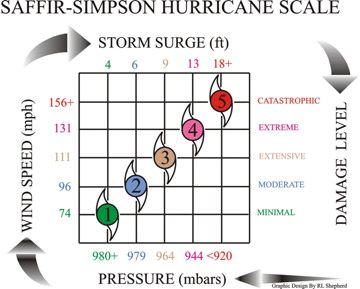Hurricane season opens on June 1st, so we’ll soon hear lots of talk about categories and wind speeds -- numbers that coastal residents ignore at their own peril.
 Saffir-Simpson Hurricane Scale. Credit: National Oceanic and Atmospheric Administration
Saffir-Simpson Hurricane Scale. Credit: National Oceanic and Atmospheric AdministrationWhen a tropical system first gets organized, it’s called a tropical depression. It’s not likely to cause much damage if it hits land. Once winds hit 39 miles per hour, it’s upgraded to a tropical storm, and it’s given a name. This year’s list of names begins with Ana.
At 74 miles an hour, the storm has a well-defined spiral pattern, with a cloud-free “eye” in the middle. At that point, it’s what people who live on the coast most dread: a hurricane.
The National Hurricane Center uses five categories to classify hurricanes. The scale was developed in the 1970s by two men.
Herbert Saffir was an engineer in Florida who’d studied ways to make structures more likely to stand up to hurricanes. And Robert Simpson was director of the National Hurricane Center.
The Saffir-Simpson scale is based on a storm’s potential for destruction. A “category one” storm, for example, causes minor wind damage and some flooding, but most structures will survive. But with winds of at least 155 miles per hour, a “category five” storm damages or destroys most houses, and causes major damage to most larger structures. It also produces devastating flooding.
One of the strongest storms to the hit the U.S. was Hurricane Camille in 1969. It blew away many of the wind gauges in its path. But scientists estimated its top winds at 190 miles an hour.

